04.12.2006
Mark Dvoretsky. Critical approach to the combination
2. The strongest one achieves the victory!
Let`s analyze the examples when the combination turns out to be either the strongest continuation or the best practical chance. We will have to play for both opponents. At first, it is necessary to find the combination and then to look for the best defense. The result of the game in such situations depends on the resourcefulness of chessplayers. The one who manages to be more inventive often scores a victory.
Rausis – Gofstein
Sophia 1988

White?
The first example clearly confirms that the result of the game often depends on the tactical skills of the players. The fact is that sometimes it is even more important than the objective evaluation of the situation on the board.
It is quite difficult to define which one of the opponents has the upper hand in this position. Some of White`s pieces can be really dangerous for Black because they are close to his king. However, Black`s pieces also cooperate well. Moreover, Black has two extra pawns.
If White can`t invent any tactical continuation, perhaps, he would play 1.¦f2? ¦:f7 2.Ґ:f7.
The primitive2...¦e7? 3.Ґc4! leadstothedefeat. However, Black will manage to achieve the opposite result if he finds either 2...¤e2+!? 3.¦:e2 (3.ўh1 Јd6! threatening with a dreadful check on d1) 3...Ґd4+ followed by 4...Ј:f7 or 2...Јd6! 3.Ґ:e8 (3.ўh1 Ґ:f4 4.¦:f4 ¦f8°) 3...Ґ:f4 4.¦:f4 ¤e2+.
But the fact is that White can find a tactical solution of the problem. It is not very difficult and White`s next move is really elegant.
1.Ґc4-e6!!
NowBlackisserving. He has a big choice of possible replies. As it often happens, there is only one right continuation.
Bad is 1...Ґ:f4?? 2.Јf6+ and 1...¦:e6?? 2.Ґ:e5+ (of course, 2.¦:c7ќis enough as well) 2...Ј:e5 3.Јh6.
1...¤f5? would be justified in case of 2.¦d7? ¦:f7! (but not 2...¦:d7? 3.¦:d7 Јb8 4.Ґ:f5ќwith the idea of 5.Јh6) 3.¦:c7 Ґd4+ 4.ўh1 ¦:c7 5.Ґ:f5 ¦f7 6.Ґg4 e3 7.Ґe2 ¦f5 8.Јg3 Ґ:b2 and it is quite difficult to evaluate this position. However, this defense is simply refuted by 2.¦:e7! ¦:e7 3.Ґ:e5+ Ј:e5 4.¦d8+ ўg7 5.¦g8#.
The situation is similar after 1...¤c6?. Well, 2.¦d7 is not the strongest continuation because of 2...¦:f7 (wrong is 2...¦:d7? 3.¦:d7 Јb8 4.¦:h7+!) 3.¦:f7 Ґd4+ 4.ўh1 Ј:f7 5.Ґ:f7 ¦f8 though White`s serious advantage raises no doubts. But the point is that simpler is 2.¦:e7 Ј:e7 (2...¦:e7 3.Ґ:e5+ Ј:e5 4.¦d8+!; 2...Ґd4+ 3.¦:d4 Ј:e7 4.¦d6) 3.Ґ:e5+ ¤:e5 4.Ј:e5+.
White has to make more effort after 1...¦:f7?! 2.Ґ:e5+ Ј:e5 (2...¦g7 3.¦:d4!) 3.Ј:e5+ ¦g7. White keeps the excellent winning chances playing 4.Ј:c5 ¤:e6 5.Ј:a7±. However, even stronger is 4.¦:d4 cd 5.Ј:e4 because the opponent doesn`t manage to use the pin on the bishop: 5...d3 6.Јd5 h5 (6...d2 7.Ґg4ќ) 7.Јd6! and 8.Ґb3ќ.
As a matter of fact, we come to the only defense by the method of exclusion.
1. . . . ¤d4:e6!
2.Ґf4:e5+ ўh8-g8
3.Јg5-f6
Less precise is 3.Јh4 ¦:f7 4.Ґ:c7 e3 5.¦e2 ¤:c7³ (Aagaard).
3. . . . Јc7:e5
4.Јf6:e5 ¦e7:f7
5.Јe5:e4 b7-b6²
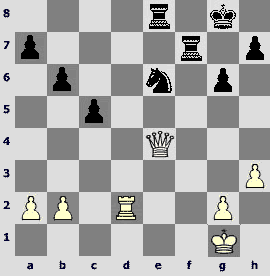
White still stands slightly better but Black should hold.
Huss – Lobron
Beer-Sheva 1985
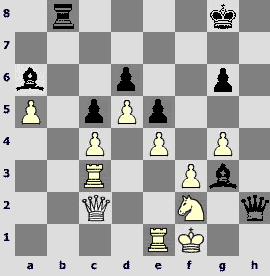
Black?
In spite of White`s serious material advantage, his is in trouble. However, 43...¦b4?! gives Black nothing because of 44.¦e2! (the only defense) 44...ўg7 45.Јa2.
Eric Lobron delivered an excellent tactical blow.
43. . . . ¦b8-b3!!
It`s quite easy to be taken aback by such a move and Andreas Huss really was. He understood that the rook was invulnerable: 44.Ј:b3?? Ј:f2# or 44.¦:b3? Ґ:c4+!. White chose 44.¦e2? but this continuation didn`t save him from the decisive invasion of his opponent`s pieces: 44...Ґ:c4!! 45.¦:c4 ¦:f3 46.ўe1 (46.¦d2 Јh1+ 47.ўe2 ¦:f2+ 48.ўd3 Јf3#) 46...Јg1+ White resigned.
using the method of exclusion t is possible to find the only possible continuation. The point is that the following move doesn`t lose at once.
44.¤f2-d3!!
Now it is very difficult for Black to prove his advantage (perhaps, it is even impossible). I give Aagaard`s analysis with my amendments and additions.
А) 44...Ј:c2 45.¦:c2 ¦:d3 (45...Ґ:e1 46.¤:e1 ¦b4 47.ўf2²) 46.¦b1! and White has a counter-play.
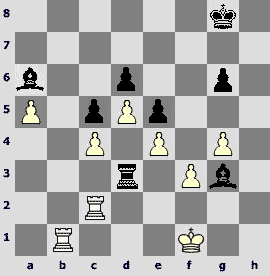
For example: 46...¦a3 47.¦b6 ¦:a5 48.¦:d6 ўf7 49.ўg2 Ґf4 50.¦d7+ (50.¦c6) 50...ўf6 51.¦a7 ¦a4 52.¦b2 Ґb5 53.¦:a4 Ґ:a4 54.¦b6+ and White`s position is not worse.
Б) 44...Јh1+ 45.ўe2 Јg2+ 46.ўd1 Ј:f3+ 47.¦e2
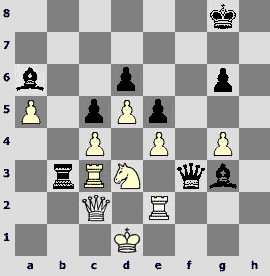
47...¦:c3 (after 47...Јf1+ 48.¤e1 ¦b4 49.¦:g3! ¦:c4 50.¦f2! ¦d4+ 51.¦d3! ¦:d3+ 52.Ј:d3 Ґ:d3 53.¦:f1 Ґ:f1 54.ўd2 White stands slightly better but the fact is that the endgame is drawn) 48.Ј:c3 Ґh4!? (on 48...Ј:g4? White replies either 49.¤e1 or 49.¤b2; 48...Ґc8 leads to a double-edged position - 49.ўd2 Ґ:g4 50.¤c1 Ґf4+ 51.ўc2) 49.Јc2 Ґg5 50.¤e1 Јa3. Black still has an excellent compensation for the exchange, the initiative is on his side but the outcome remains unclear.
Goodman – Nunn
England 1978
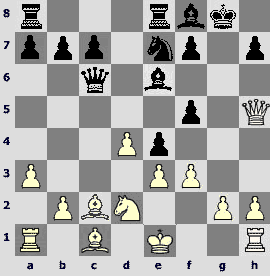
White?
17.¤d2:e4!
White has to search for a combination. Otherwise, he has nothing to claim to. Let`s try to find how Black can defend this position.
John Nunn didn`t cope with the task. He played 17...Ј:c2? (also unsatisfactory is 17...fe? 18.Ґ:e4) 18.¤f6+ ўg7 19.e4!. Black is defenseless. After 19...Ј:g2 White gives checkmate in two moves playing either 20.Јh6+ ўh8 21.Ј:h7# or 20.Ј:h7+ ў:f6 21.e5#. The same end waits for Black in case of 19...¤g6 – 20.Јh6+ ў:f6 21.Ґg5#. Then followed 19...Ј:c1+ 20.¦:c1 ў:f6 21.Ј:h7 ¤g6 22.e5+ ўg5?! 23.h4+ ўf4 24.ўf2. Black resigned.
It is time to remember that chess is not draughts. Black is not obliged to recapture.
17. . . . ¤e7-d5!
18.¤e4-c5
After 18.Ґd3 fe 19.fe ¤f6 20.Јh4 Ґg7 21.0-0 (21.e5 Ј:g2) 21...Ґc4! 22.Ґ:c4 Ј:c4 23.¦:f6 Ґ:f6 24.Ј:f6 ¦:e4 or 24...Јe2 the perpetual check ends the struggle.
18. . . . Ґf8:c5
19.d4:c5 Јc6:c5
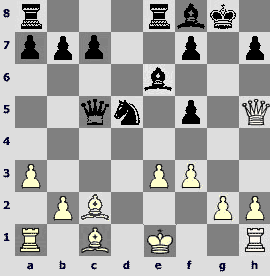
Dangerous is 20.Ґ:f5?! Ґ:f5 21.Ј:f5 because of 21...¦:e3+! 22.Ґ:e3 Ј:e3+ 23.ўf1 (23.ўd1? ¦d8°) 23...Јd2 24.¦e1 ¤e3+ 25.¦:e3 Ј:e3 and Black has the advantage. In case of 20.Ґd3 f6 21.Јh6 ¦ad8 the position is really double-edged.
Sznapik – Drasko
Polanica Zdroj 1985
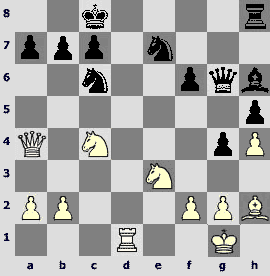
White?
An attempt of the queenside advance 24.b4? is neutralized by 24...Ґ:e3 25.¤:e3 Јe4.
24.¤c4-b6+!!
An excellent combinational blow poses a difficult problem for Black. Will you be able to resolve it?
Black refused to accept the challenge and played 24...ўb8?. After 25.¤d7+ ўa8 (on 25...ўc8 White makes the same move) 26.¤c4! Black couldn`t find a satisfactory defense against 27.¤cb6+ and 27.Ґ:c7.
26...a6 (26...¤e5 27.¤de5 fe 28.Ґ:e5 ¦c8 29.Јd7ќ) 27.Ґ:c7 ¤f5 28.Ґb6 (28.¤cb6+ ўa7 29.¤d5 ¦c8 30.Јa3 won faster) 28...g3 29.Ґc5 gf+ 30.Ґ:f2 ¦g8 31.¤cb6+ ўa7 32.¤d5+ b6 (32...ўa8 33.¤c7#) 33.Ґ:b6+ ўb7 34.¤c5+ ўb8 35.¤:a6+ ўb7 36.¤c5+. Black resigned.
It was necessary to take the knight. Actually, the question is which pawn had to do it.
In case of 24...cb?! 25.¤c4! there is only one way of defending against the threats 26.Ј:a7! and 26.¤:b6+! ab 27.Јa8+ – A nice move 25...Ґe3! distracts White`s knight of the attack. However, after 26.¤:e3 ¦d8 27.¦c1 Black`s position is still difficult.
24. . . . a7:b6!
25.¤e3-c4!
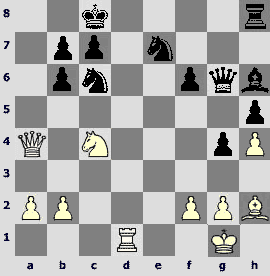
Black?
25. . . . Ґh6-e3!!
The following variations show that the only opportunity of defending Black`s position consists in this striking blow.
25...¤a5?? 26.¤:b6+!;
25...¤b8?? 26.¤:b6+ cb 27.Јc4+ и 28.Јe6+;
25...ўb8? 26.¤:b6 ¤a7 27.¤d7+ ўa8 28.Ґ:c7ќ.
26.Јa4-a8+!
Of course, wrong is 26.fe?? g3°. After 26.¤:e3 ўb8 White keeps some kind of initiative but it is very difficult to derive benefit from it.
26. . . . ¤c6-b8
27.¤c4:e3 Јg6-e4
28.¦d1-c1 ¤e7-c6
Aagaard analyzed 29.¤c4 Јd4! 30.b4 ¦d8!? 31.Ґg3 ¤e5 32.¤:e5 fe - the game is even. Many years ago I also analyzed this position and decided that it is sensible to try 29.b4! immediately because White`s pawn is invulnerable. It is rather unpleasant to defend this position. For example: 29...¦h7 30.b5!? (30.¤c4) 30...¤d4 31.ўh1 ¤e2 32.¦e1 g3 33.Јa3! andWhite has better chances.
Timman – Speelman
London 1982
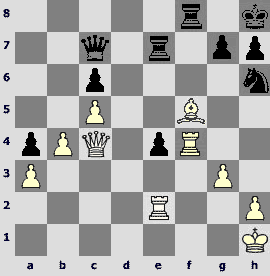
White?
White`s pieces are vulnerable and it is quite difficult to choose a correct continuation.
White loses after both 37.¦f:e4? ¤:f5 and 37.Ґ:e4? ¦:f4 38.gf Ј:f4. White`s bishop is pinned twice and his king runs the danger indeed.
In case of 37.Ґe6? ¦:f4 38.gf Ј:f4 39.¦:e4 Јf3+ 40.ўg1 Ј:a3 Black`s advantage is significant.
Jonathan Speelman chose 37.¦ef2? hoping for 37...e3?? 38.Ґd3!. However, after Black`s powerful reply 37...g5! White can`t avoid the material losses. So the game ended in the following way: 38.¦:e4 ¦:f5 39.Јd4+ ўg8 40.Јc4+ ¦ff7 41.¦fe2 ¦:e4 42.¦:e4 (42.Ј:e4 ¤f5) 42...Јd7 43.¦d4 Јe7 44.¦e4 Јf6 45.g4 Јf3+ 46.ўg1 Јf2+ 47.ўh1 ўf8 48.Јd3 ¦d7! 49.Јe2 Ј:e2 50.¦:e2 ¤g8 51.¦e5 ¤e7 52.ўg2 ¦d3. White resigned.
Commenting on the game Speelman indicated the only correct continuation.
37.¦e2:e4!
The idea of this move reveals in a spectacular variation 37...¦:f5?! 38.¦:f5 ¤:f5 39.Јf7!!. It is possible to continue: 39...Јd8 40.Ј:f5 Јd1+? (better is 40...¦:e4 41.Ј:e4±) 41.ўg2 Јc2+ 42.ўh3 and the weakness of the 8th rank lets Black down again.
37. . . . ¤h6:f5
38.g3-g4!
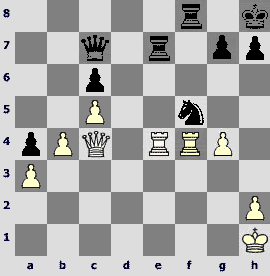
Black?
Speelman analyses only 38...Ј:f4? 39.¦:f4 ¦e1+ 40.ўg2 ¤e3+ 41.ўh3ќ.
Also unsatisfactory is 38...¦d8? 39.¦:f5 ¦d1+ 40.ўg2 ¦d2+ 41.ўf3 Јd8 42.¦:e7 Ј:e7 43.Јe4ќ.
However, Black has a simple defense.
38. . . . g7-g6!
39.g4:f5 ¦f8:f5
It is also possible to play 39...gf².
40.¦f4:f5 g6:f5²
A draw seems to be the most likely result (John Nunn`s analysis).
Kapengut – Begun
Minsk 1976

White?
It is very important for White to find the grounds for the attack that begins with the exchange sacrifice on e4. Otherwise, the alternative continuation 25.¤e3 ¤g5 26.Јg2 ¤:e3 dooms him to the defense of a hard position.
25.¦e2:e4!
Sergey Begun chose the worst of three possible captures: 25...hg? and after 26.¦:g4 ¤:b2 27.¤f5+ ўf8 28.¤h4! he was confronted with the serious difficulties. The rook is invulnerable: 28...¤:d1?? 29.¤:g6+ ўg7 30.¤e7+ ўf8 31.Јf6!ќ. Black didn`t want to defend the position without a pawn after 28...ўg7!? 29.¦:d5 ¦:d5 30.Ј:d5± but probably, it was the best chance.
28...¦e6
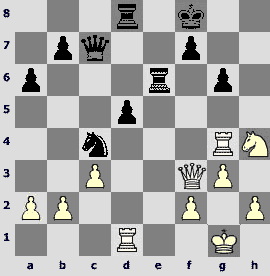
29.¦dd4. Aagaard suggests two promising continuations: 29.¦:g6!? ¦:g6 (29...¤:d1 30.¦:e6 Ј:c3 31.Јf4! ¦c8 32.¤g6+ ўg7 33.Јg5!!ќ) 30.¤:g6+ ўg7 31.¦b1 fg 32.¦:b2± and 29.¦d2!? ¤c4 30.¦e2 ¤e5 (30...¦:e2 31.¤:g6+) 31.¦:e5 Ј:e5 32.¤:g6+ ¦:g6 33.¦:g6±.
To my mind, 29.¦dd4 doesn`t lose the advantage either.
29...Јc6 30.¦g5?. Now Black achieves the equal game. It was necessary to play 30.Јf4! followed by 31.¤f3±.
30...¤c4! 31.¦g:d5 ¦:d5 32.¦:d5 ¦e1+ 33.ўg2 ¤e5 34.¦d8+ ўe7 35.Ј:c6 ¤:c6 36.¤f3 ¦a1 37.¦d2 ¦c1 38.¦e2+ ўf8 39.¤g5 ¦:c3 40.¤e4 ¦c1 41.g4 ¤d4 42.¦d2 ¤e6 43.g5 ¦c4 44.f3 ўe7 45.¤d6. Draw
The simplest way of maintaining equilibrium consisted in taking on e4 with the rook: 25...¦:e4! 26.Јf6+ ўf8. For example: 27.f3 hg (or27...¦:d4 28.cdЈb6=) 28.feўg8= (Dvoretsky).
Now try to define the consequences of taking with a pawn. It is rather difficult but if you cope with this task then Aagaard`s solution will give you real pleasure.
25. . . . d5:e4!
26.Јf3-f6+ ўg7-h7
27.¤d4-f5! ¦d8:d1+
28.ўg1-g2
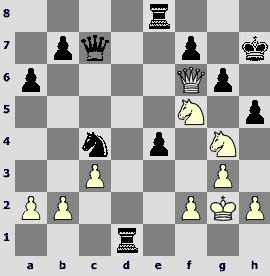
Black?
28. . . . ¤c4-e3+!!
A brilliant counter-blow. It was necessary to foresee it when taking a decision on the 25th move. Black loses after 28...¦g8? 29.Јg5 and 29...¤e3+ doesn`t help him because of 30.¤f:e3 hg 31.¤:g4ќ.
Which piece should take Black`s knight?
Weak is 29.¤f:e3? in view of 29...¦d6 30.Јg5 hg°.
On 29.¤g:e3 it is better to play 29...gf! (after 29...¦g8 30.¤:d1 gf 31.Ј:f5+² Black still has to be rather accurate) 30.¤:f5 Јe5! 31.Јh6+ ўg8 32.Јg5+ and the game ended with perpetual.
29.f2:e3 ¦e8-g8
It is possible to insert a couple of checks (but only two!) before putting the rook at g8: 29...¦d2+ 30.ўg1 ¦d1+ 31.ўf2 ¦d2+? (the last chance for 31...¦g8!) 32.ўe1 ¦g8 33.ў:d2 Јc4 (33...Јd8+ 34.ўc1 hg 35.Ј:f7+ ўh8 36.¤e7ќ) 34.b3 Јd3+ 35.ўc1 Јf1+ 36.ўb2 Ј:f5 37.Ј:f5 gf 38.¤f6+ ўg7 39.¤:g8 ў:g8 40.ўa3 ўf8 41.ўb4 and White wins this pawn ending easily.
30.Јf6-g5 ¦d1-d2+
31.ўg2-g1
31.ўf1?? Јc4+!
31. . . . ¦d2-d1+
32.ўg1-f2 ¦d1-d2+
33.ўf2-e1 ¦d2-d1+!!
It is the main point of the defensive plan. Black`s rook is invulnerable because White can`t allow the exchange of queens (34.ў:d1?? Јd8+ °).
34.ўe1-f2 ¦d1-d2+
Perpetual check!
Two following examples were found and analyzed by Ogard. Theyaresuitableforthetraininggameagainst the equal opponent. In this case you can compete in the inventiveness and the accuracy of calculation.
Frumkin – Dubinsky
New York 2000

Black?
The game continued the following way: 1...¦:c1? 2.¦:c1 Јh4 3.Јc5! (equal is 3.Јc3!) – the threat 4.Јc8+ ўh7 5.Јf5+ turned the scale in favor of White.
To 1...¦:a8? it is possible to reply 2.Ґg2!? fg 3.¦:e2 f3 4.¦e3ќ.
1. . . . Јf6-h4!!
Now the tempo is more important than the rook!
2.¦c1:c8+
In case of 2.Ј:e7? Black wins by either 2...Ј:h3 or 2...¦:c1.
2. . . . ўh8-h7
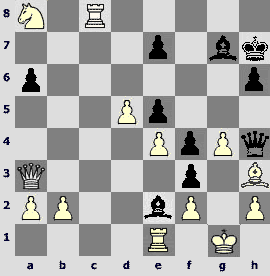
White?
The threats to White`s king seem to be irresistible. For example: 3.Ґg2? Ј:g4; 3.ўh1? Ј:h3 4.¦g1 Ґf1!°. The queen sacrifice 3.¦:e2? Ј:h3 4.Ј:f3 Ј:f3 doesn`t weaken the opponent`s attack: 5.¦cc2 Ј:g4+ 6.ўf1 f3° or 5.¦ec2 Јd1+ (5...Ј:g4+) 6.ўg2 f3+ 7.ўg3 Јh1°.
White`s only hope consists in driving his queen close to the opponent`s king in order to give the perpetual.
3.¦c8-h8+!!
The only move! 3.¦g8? doesn`t help White because of 3...ў:g8! (but not 3...Ј:h3? 4.¦:g7+! ўh8 5.¦h7+! ўg8 6.¦g7+!) 4.Јc5 Ј:h3 5.Јc8+ Ґf8! 6.Јe6+ ўh8 7.Ј:e5+ Ґg7 8.Јb8+ ўh7°.
White can`t change the moves order: 3.Јc5? Ј:h3 4.¦h8+ Ґ:h8! 5.Ј:e7+ Ґg7°.
3. . . . ўh7:h8
In this situation Black can even lose after 3...Ґ:h8? 4.g5!! Ј:h3 5.Ј:e7+ Ґg7 6.g6+! ў:g6 7.Јe6+. In case of 3...ўg6 White forces a draw playing 4.¦g8! (worse is 4.Јa4 Ґb5µ) 4...Ј:h3 5.¦:g7+ ў:g7 6.Ј:e7+.
4.Јa3-c5
Or 4.Јc3.
4. . . . Јh4:h3
5.Јc5-c8+ ўh8-h7
6.Јc8-f5+ ўh7-g8
7.Јf5-e6+!
But not 7.Јc8+?? Ґf8!°.
7. . . . ўg8-h8
8.Јe6-c8+
Dukewort – Silman
USA 1988
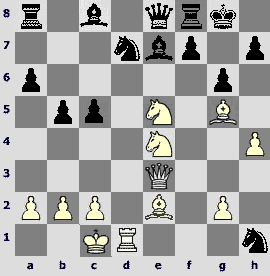
White?
The game continued 1.¤:d7?! Ґ:d7 2.Ґf6 (in case of 2.Ґh6 Black wins by either 2...f5 3.Ґ:f8 Ј:f8 or 2...Ґc6 3.Ґ:f8 Ј:f8 4.¦:h1 ¦e8 5.Ґf3 Ґ:e4 6.Ґ:e4 Ґf6) 2...¤g3! This elegant move repels White`s threat 3.Јh6. The point is that now Black has 3...¤f5. 3.Ј:g3 Ґc6 4.¤d6 (if 4.Јg5 Ґ:e4 5.Ґ:e7 then 5...f6!° – Dvoretsky) 4...Ґ:d6 5.¦:d6 Ј:e2 6.Јf4 ¦ae8 and it is time to resign.
The fact is that it is too late to be careful. Black has an extra rook and White can rely only on his attack.
According to Jeremy Silman, White could save himself playing 1.¦d1:d7. Unfortunately, Aagaard found two weak points of his analysis.
1.¦d1:d7!
In the first place, it is not necessary to take the rook. Black wins by 1...f6!
If Black makes this move during the training it is necessary to interrupt the game admitting he is right and to ask him to defend the other way.
1. . . . Ґc8:d7?!
2.Ґg5-f6
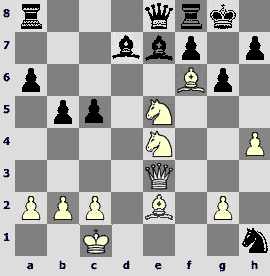
Black?
Now the best way of repelling the threat of 3.Јh6 is the same one that was realized in the game. I analyzed the variations 3...Јd8? 3.¤:d7 Ґ:f6 4.¤e:f6+ ўg7 5.Јc3 ўh8 (the only move) 6.Ґf3± and 2...Ґ:f6?! 3.¤:f6+ ўg7 4.¤:e8+ (4.¤h5+ is enough for the draw) 4...¦a:e8 5.Ј:c5². They are advantageous for White.
2. . . . ¤h1-g3!
3.Јe3-h6?!
To my mind, stronger is 3.Ј:g3!. The following variation leads to a draw: 3...Ґf5 4.Јg5 Ґ:e4 5.¤g4! Ґ:f6 6.¤:f6+ ўg7 (6...ўh8?! 7.Јh6 g5 8.¤:e8±) 7.¤h5+! (7.¤:e8? ¦f:e8µ) 7...ўg8 8.¤f6+. That`s why the opponent replies 3...Јd8!. Now White is at the crossroads.
After 4.Јg5!? h6! there is an interesting ratio of material in the following variations: Black`s two rooks against White`s three pieces.
а) 5.Ґ:e7 hg 6.Ґ:d8 ¦f:d8 7.¤:d7 ghµ;
б) 5.Јf4 ¦a7! 6.Ґg4! Ґe8 7.Ґf3 (White threatens with 8.¤g4) 7...Ґ:f6 8.¤:f6+ ўg7 9.¤eg4 ¦h8 10.Јe5 Јd4! 11.¤:e8+ ўf8 12.¤ef6 Ј:e5 13.¤:e5 ўg7µ.
In case of 4.Јf4!? (instead of 4.Јg5) 4...¦a7 5.Ґg4! Ґe8 6.Ґf3 it is bad to check on f6 while to 6...h5 unpleasant is 7.Јg5. It is necessary to play 4...Ґf5! 5.¤c6 Ґ:f6 6.¤:d8 Ґ:d8 (6...Ґ:e4? 7.Ј:f6 ¦f:d8 8.h5=) 7.¤:c5 Ґb6µ.
Everywhere Black has the advantage but White continues fighting.
3. . . . ¤g3-f5
4.¤e5-g4!
White took on d7 with the rook for the sake of this move. White`s queen is invulnerable. Black loses after 4...Ґd6? 5.Ґe5 (or 5.Ґc3). After 4...Јb8 5.¤g5 Јf4+ 6.ўb1 Ј:g5 7.Ј:g5 (also interesting is 7.hg ¦fe8 8.Јh3) 7...¦fe8! the position is unclear.
4. . . . Ґe7-d8!
Black`s queen starts working along the e-file. If 5.Ґf3 Ґc6 6.¤g5 then Black plays 6...Јe3+!! distracting White`s knight from the h6 square.
5.¤e4-g5
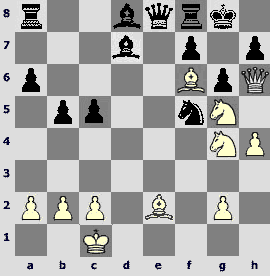
Black?
5. . . . Јe8-e3+!!
As a matter of fact, White`s knight doesn`t control the e3 square because it has to defend the queen.
6.ўc1-d1
According to Silman, Black has to be satisfied with a draw after 6...Јg1+ 7.ўd2 Јe3+ 8.ўd1 Јg1+ The other way is to fight for the victory in the unclear position after 6...Ј:g5 7.hg ¦e8 8.Јh2.
Aagaard came to a different conclusion.
6. . . . Јe3:e2+!!
7.ўd1:e2 ¦f8-e8+
8.ўe2-f2
Now it is impossible to take the queen. However, it will be possible if Black frees the e8 square for his king.
8. . . . ¦e8-e2+!!
9.ўf2:e2 ¤f5:h6
10.¤g4:h6+ ўg8-f8
11.¤g5:h7+ ўf8-e8
White has no checks anymore. In spite of great sacrifices, Black still has the material advantage that is definitely enough for the victory. .
